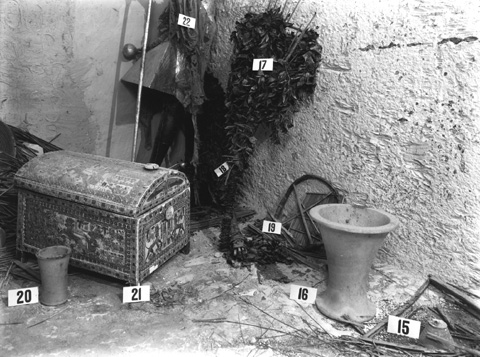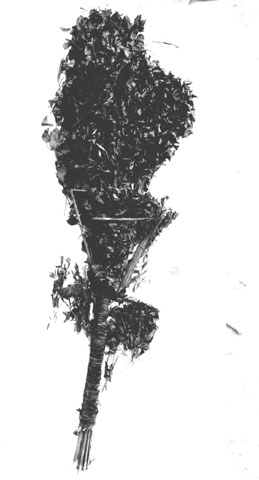Olives are not native to Egypt, and it may come as a surprise that olive leaves were found in bouquets and wreaths in the tomb of the 'boy Pharaoh', Tutankhamun. In fact, olives have been cultivated in Egypt since around 1500 B.C. By about 1327 B. C., the date of Tutankhamun's burial, they were being cultivated quite widely, in private gardens as well as in the gardens of temples and mortuaries, where they provided oil for religious ritual and burial ceremonies.
In November 1922 Howard Carter began his famous excavation of Tutankhamun's tomb. The excitement the excavators felt can be seen in the words of Carter himself. When he reached the north wall of the Antechamber, which he had found to be filled with tomb furniture, and came to a sealed doorway, "...visions of chamber after chamber, each crowded with objects like the ones we had seen, passed through our minds and left us gasping for breath".
| Burton Photo. No. P0016 |
 |
Photo copyright: Griffith Institute, University of Oxford
This fascinating second image clearly shows how reeds formed long handles for the bouquet, and the framework that held the olive and persea stems in place. We can imagine these tall bouquets being carried in the funeral procession, brought into the tomb and left there when the door to the Burial Chamber was sealed.
Position: Standing erect, against wall to right of doorway. 19 up from bottom, unbound brach (sic) ends, about 10 of them. Rest of handle above this bound round tightly with leaves applied singly. They were held in place by a binding of reed strip, now almost entirely disappeared. Above a triangular frame of reed stalk. Above apparently branches were loose. About 60 wide at widest point above. Width of triangular frame 34. Diam. of handle about 6......Sprayed with a solution of celluloid in acetone.
I imagine that these measurements are metric; with the unbound branch ends measuring 19 cm. from the bottom, it must have been a large and imposing bouquet. I don't know how well the celluloid in acetone would have preserved the bouquets, or whether indeed the bouquets still exist. But it is wonderful to see these photographs from the original excavations, and to read the archaeologist's description, and I am grateful to the Griffith Institute for granting me permission to publish them here.






















